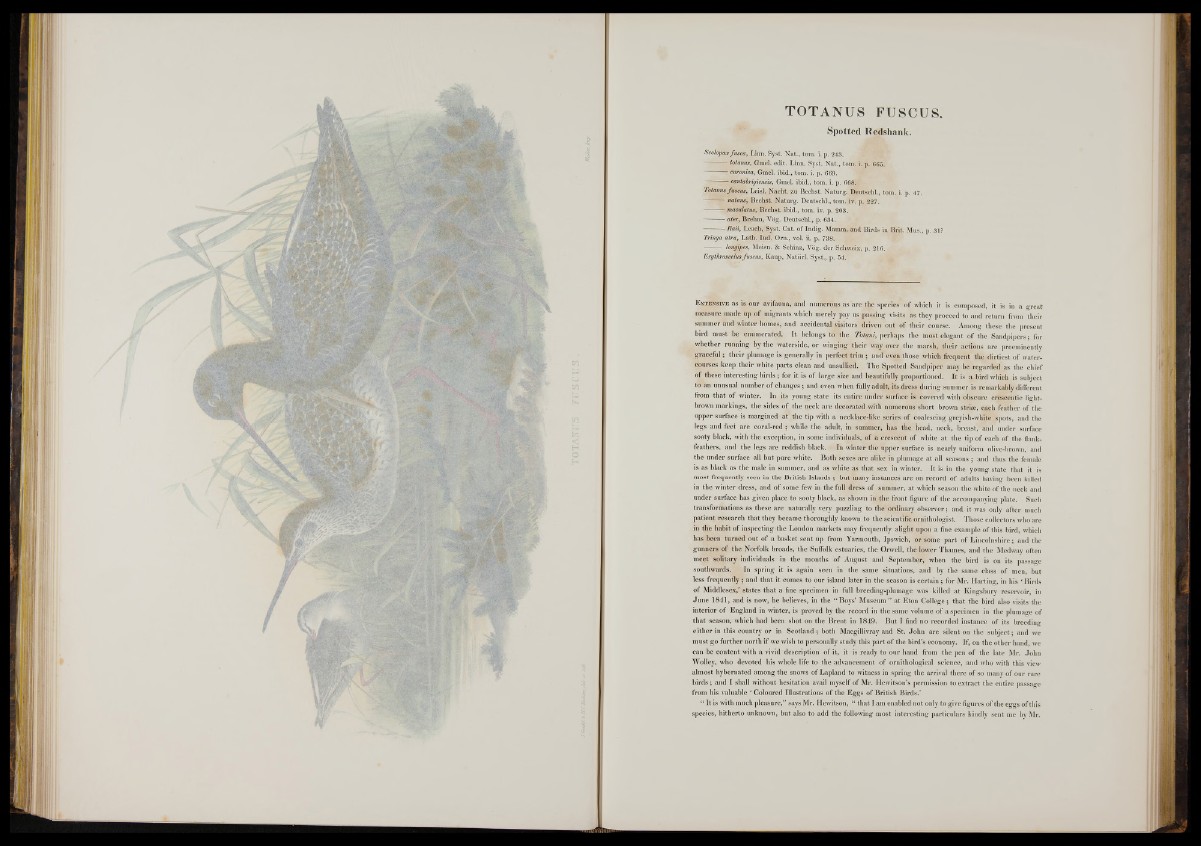
TOTANUS FUSCUS.
Spotted Redshank.
Scolopax fusca, Linn. Syst. Nat., tom. i. p. 243.
— ; totanus, Gmel. edit. Linn. Syst. Nat., tom. i. p. 665.
r curonica, Gniel. ibid., tom. i. p. 669.
— cantabrigiensis, Gmel. ibid., tom. i. p. 668.
Totanus fuscus, Leisl. Nacht. zu Bechst. Naturg. Deutschl., tom. i. p. 47.
— natans, Bechst. Naturg. Deutschl., tom. iv. p. 227.
maculatus, Bechst. ibid., tom. iv. p. 203.
ater, Brehm, Yog. Deutschl., p. 634.
Raii, Leach, Syst. Cat. of Indig. Mamm, and Birds in Brit. Mus., p. 31?
Tringa atra, Lath. Ind. Orn., vol. ii. p. 738. -
— longipes, Meisn. & Schinz, Vog. der Schweiz, p. 216.
Erythroscelusfuscus, Kaup, Natiirl. Syst., p. 54.
E x t e n s iv e as is our avifauna, and numerous as are the species of which it is composed, it is in a great
measure made up o f migrants which merely pay us passing visits as they proceed to and return from their
summer and winter homes, and accidentalvvisitors driven out of their course. Among these the present
bird must be enumerated. It belongs td the Totani, perhaps the most elegant of the Sandpipers; for
whether running by the waterside, o r winging their way over the marsh, their actions are preeminently
graceful; their plumage is generally in perfect trim ; and even those which frequent the dirtiest of watercourses
keep their white parts clean and unsullied. The Spotted Sandpiper may be regarded as the chief
o f these interesting b ird s; for it is of large size and beautifully proportioned. I t is a bird which is subject
to an unusual number of changes; and even when fully adult, its dress during summer is remarkably different
from that o f winter. In its young state its entire under surface is covered with obscure crescentic light-
brown markings, the sides of the neck are decorated with numerous short brown strise, each feather of the
upper surface is margined a t the tip with a necklace-like series of coalescing greyish-white spots, and the
legs and feet are coral-red ; while the adult, in summer, has the head, neck, breast, “and under surface
sooty black, with the exception, in some individuals, o f a crescent of white at the tip o f each o f the flank-
feathers, and the legs are reddish black. In winter the upper surface is nearly uniform olive-brown, and
the under surface all but pure white. Both sexes are alike in plumage a t all seasons ; and thus the female
is as black as the male in summer, and as white as that sex in winter. It is in the young state that it is
most frequently seen in the British Islands ; but many instances are on record of adults having been killed
in the winter dress, and o f some few in the full dress of summer, a t which season the white of the neck and
under surface has given place to sooty black, as shown in the front figure o f the accompanying plate. Such
transformations as these are naturally very puzzling to the ordinary observer; and it was only after much
patient research that they became thoroughly known to the scientific ornithologist. Those collectors who are
in the habit of inspecting the London markets may frequently alight upon a fine example o f this bird, which
has been turned out of a basket sent up from Yarmouth, Ipswich, or some part of Lincolnshire; and the
gunners of the Norfolk broads, the Suffolk estuaries, the Orwell, the lower Thames, and the Medway often
meet solitary individuals in the months o f August and September, when the bird is on its passage
southwards. In spring it is again seen in the same situations, and by the same class of men, but
less frequently; and th at it comes to our island later in the season is c e rta in ; for Mr. Harting, in his ‘ Birds
of Middlesex,’ states th at a fine specimen in full breeding-plumage. was killed a t Kingsbury reservoir, in
Ju n e 1841, and is now, he believes, in the “ Boys’ Museum” a t Eton College; th at the bird also visits the
interior o f England in winter, is proved by the record in the same volume o f a specimen in the plumage of
th at season, which had been shot on the Brent in 1849. But I find no recorded instance o f its breeding
either in this country or in Scotland; both Macgillivray and St. John are silent on the subject; and we
must go further north if we wish to personally study this p art o f the bird’s economy. If, on the other hand, we
can be content with a vivid description o f it, it is ready to our hand from the pen of the late Mr. John
Wolley, who devoted his whole life to the advancement of ornithological science, and who with this view
almost hybernated among the snows o f Lapland to witness in spring the arrival there o f so many o f our rare
b ird s ; and I shall without hesitation avail myself o f Mr. Hewitson’s permission to extract the entire passage
from his valuable ‘ Coloured Illustrations of the Eggs o f British Birds.’
“ I t is with much pleasure,” says Mr. Hewitson, “ that I am enabled not only to give figures of the eggs of this
species, hitherto unknown, but also to add the following most interesting particulars kindly sent me by Mr.